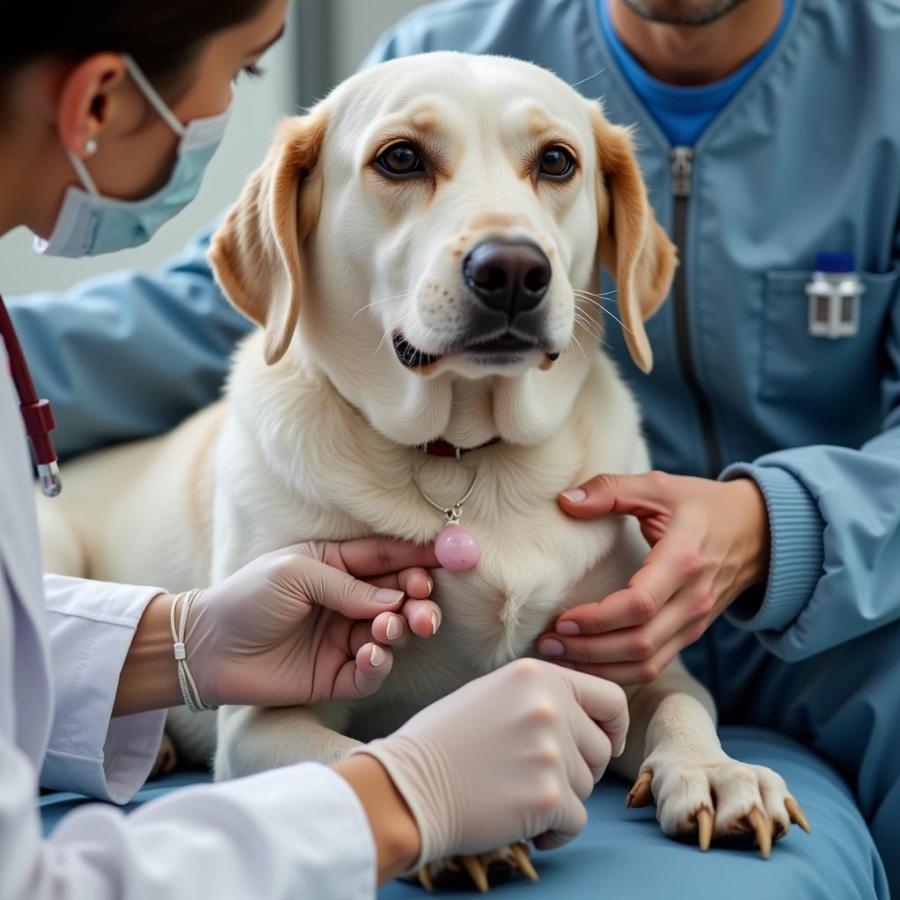My dog’s balls are red. This is a common concern among dog owners and can be a sign of several underlying issues, ranging from minor irritation to serious infection. Understanding the causes, symptoms, and treatment options for testicular redness is crucial for ensuring your furry friend’s health and well-being. This comprehensive guide will delve into everything you need to know about red testicles in dogs, equipping you with the knowledge to identify potential problems and take appropriate action.
Causes of Red Testicles in Dogs
Several factors can contribute to redness in a dog’s testicles. Some common causes include:
- Irritation: Simple irritation from environmental factors like grass, allergens, or rough fabrics can cause temporary redness.
- Trauma: Injury to the testicles, such as a bite or blunt force trauma, can result in inflammation and redness.
- Infection: Bacterial or fungal infections can affect the skin and tissues of the scrotum, leading to redness and discomfort.
- Allergies: Allergic reactions to food, pollen, or other allergens can manifest as skin inflammation, including redness in the scrotal area.
- Testicular Torsion: This is a serious condition where the testicle twists on its cord, cutting off blood supply. This can cause severe pain and redness.
- Orchitis: Inflammation of the testicle itself, often caused by infection.
- Epididymitis: Inflammation of the epididymis, the tube that carries sperm.
- Inguinal Hernia: A protrusion of abdominal contents into the inguinal canal, which can sometimes involve the scrotum and cause redness.
Symptoms Associated with Red Testicles
While redness is a primary indicator, other symptoms might accompany it, depending on the underlying cause. These include:
- Swelling
- Licking or biting at the area
- Discomfort or pain
- Lethargy
- Fever
- Discharge from the penis
- Difficulty urinating
When to Seek Veterinary Care
If you notice any redness or swelling in your dog’s testicles, it’s crucial to consult a veterinarian, especially if accompanied by other symptoms like pain, discharge, or lethargy. Early diagnosis and treatment can prevent potential complications and ensure a faster recovery.
 Kiểm Tra Tinh Hoàn Cho Chó
Kiểm Tra Tinh Hoàn Cho Chó
Diagnosing the Cause of Redness
A veterinarian will perform a thorough physical examination and may recommend additional tests to determine the underlying cause of the redness. These tests might include:
- Blood tests: To check for infection or other systemic issues.
- Urine analysis: To evaluate kidney function and detect any abnormalities.
- Ultrasound: To visualize the testicles and surrounding tissues for signs of torsion, tumors, or other structural problems.
- Culture and sensitivity testing: To identify the specific bacteria or fungus causing an infection and determine the appropriate antibiotic or antifungal treatment.
Treatment Options for Red Testicles
Treatment will vary depending on the diagnosis. Some common treatments include:
- Antibiotics or antifungals: For infections.
- Anti-inflammatory medications: To reduce swelling and pain.
- Pain management: To ensure the dog’s comfort during recovery.
- Surgery: In cases of testicular torsion or other structural abnormalities.
- Cold compresses: Can provide temporary relief from swelling and discomfort.
Preventing Testicular Problems in Dogs
While not all testicular issues are preventable, some measures can help reduce the risk:
- Regular grooming: Keep the area clean and dry to minimize irritation.
- Neutering: This eliminates the risk of testicular torsion and certain types of testicular cancer.
- Protecting your dog from trauma: Supervise your dog during play and avoid situations where they could injure their testicles.
- Prompt veterinary care: Addressing any signs of redness or swelling early can prevent complications.
What if My Dog’s Balls are Red and Swollen?
Redness and swelling often occur together and signal a more serious issue. It could indicate an infection, trauma, or even testicular torsion. Immediate veterinary attention is crucial in these cases.
Why are My Dog’s Balls Red After Mating?
Some redness and swelling can occur after mating due to increased blood flow and friction. However, if the redness persists or worsens, or if other symptoms develop, consult a veterinarian.
Conclusion
Red testicles in dogs can indicate various underlying health issues, from minor irritations to serious conditions like testicular torsion. Prompt veterinary attention is essential for accurate diagnosis and effective treatment. By understanding the causes, symptoms, and preventative measures, you can help ensure your dog’s testicular health and overall well-being. Remember, early intervention is key to a successful recovery. If your dog’s balls are red, don’t hesitate to contact your vet.
FAQ
-
Q: Can neutering prevent testicular redness?
- A: Neutering removes the testicles, eliminating the risk of testicular redness related to testicular conditions.
-
Q: Is testicular redness always a serious problem?
- A: Not always. Minor irritation can cause temporary redness. However, persistent redness warrants veterinary attention.
-
Q: How can I tell if my dog’s testicular redness is painful?
- A: Signs of pain include licking or biting the area, whining, restlessness, and reluctance to move.
Related Articles on Beaut Dogs:
- best toys for big dogs
- how to stop smegma in dogs
- how can i get my dog’s breath to smell better
- swimming pool toys for dogs
Beaut Dogs is your trusted source for comprehensive information on dog care, offering expert advice on everything from breed selection to health and wellness. For personalized support and answers to your specific questions, please contact us via Email: [email protected]. Beaut Dogs is committed to providing you with accurate and reliable information to help you care for your beloved canine companion.